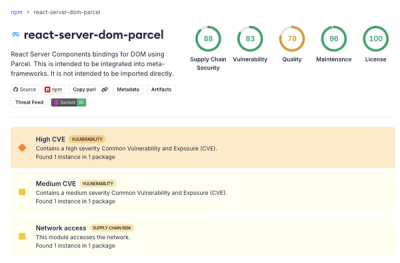
Security News
Deno 2.6 + Socket: Supply Chain Defense In Your CLI
Deno 2.6 introduces deno audit with a new --socket flag that plugs directly into Socket to bring supply chain security checks into the Deno CLI.
react-snap
Advanced tools



Pre-renders a web app into static HTML. Uses Headless Chrome to crawl all available links starting from the root. Heavily inspired by prep and react-snapshot, but written from scratch. Uses best practices to get the best loading performance.
react-snapshot but works with any technology (e.g., Vue).Zero configuration is the main feature. You do not need to worry about how it works or how to configure it. But if you are curious, here are details.
Install:
yarn add --dev react-snap
Change package.json:
"scripts": {
"postbuild": "react-snap"
}
Change src/index.js (for React 16+):
import { hydrate, render } from "react-dom";
const rootElement = document.getElementById("root");
if (rootElement.hasChildNodes()) {
hydrate(<App />, rootElement);
} else {
render(<App />, rootElement);
}
That's it!
To do hydration in Preact you need to use this trick:
const rootElement = document.getElementById("root");
if (rootElement.hasChildNodes()) {
preact.render(<App />, rootElement, rootElement.firstElementChild);
} else {
preact.render(<App />, rootElement);
}
Install:
yarn add --dev react-snap
Change package.json:
"scripts": {
"postbuild": "react-snap"
},
"reactSnap": {
"source": "dist",
"minifyHtml": {
"collapseWhitespace": false,
"removeComments": false
}
}
Or use preserveWhitespace: false in vue-loader.
source - output folder of webpack or any other bundler of your choice
Read more about minifyHtml caveats in #142.
Example: Switch from prerender-spa-plugin to react-snap
Only works with routing strategies using the HTML5 history API. No hash(bang) URLs.
Vue uses the data-server-rendered attribute on the root element to mark SSR generated markup. When this attribute is present, the VDOM rehydrates instead of rendering everything from scratch, which can result in a flash.
This is a small hack to fix rehydration problem:
window.snapSaveState = () => {
document.querySelector("#app").setAttribute("data-server-rendered", "true");
};
window.snapSaveState is a callback to save the state of the application at the end of rendering. It can be used for Redux or async components. In this example, it is repurposed to alter the DOM, this is why I call it a "hack." Maybe in future versions of react-snap, I will come up with better abstractions or automate this process.
Make sure to use replace: false for root components
If you need to pass some options for react-snap, you can do this in your package.json like this:
"reactSnap": {
"inlineCss": true
}
Not all options are documented yet, but you can check defaultOptions in index.js.
Experimental feature - requires improvements.
react-snap can inline critical CSS with the help of minimalcss and full CSS will be loaded in a non-blocking manner with the help of loadCss.
Use inlineCss: true to enable this feature.
TODO: as soon as this feature is stable, it should be enabled by default.
Also known as code splitting, dynamic import (TC39 proposal), "chunks" (which are loaded on demand), "layers", "rollups", or "fragments". See: Guide To JavaScript Async Components
An async component (in React) is a technique (typically implemented as a higher-order component) for loading components on demand with the dynamic import operator. There are a lot of solutions in this field. Here are some examples:
It is not a problem to render async components with react-snap, the tricky part happens when a prerendered React application boots and async components are not loaded yet, so React draws the "loading" state of a component, and later when the component is loaded, React draws the actual component. As a result, the user sees a flash:
100% /----| |----
/ | |
/ | |
/ | |
/ |____|
visual progress /
/
0% -------------/
react-loadable and loadable-components solve this issue for SSR. But only loadable-components can solve this issue for a "snapshot" setup:
import { loadComponents, getState } from "loadable-components";
window.snapSaveState = () => getState();
loadComponents()
.then(() => hydrate(AppWithRouter, rootElement))
.catch(() => render(AppWithRouter, rootElement));
If you don't use babel plugin, don't forget to provide modules:
const NotFoundPage = loadable(() => import("src/pages/NotFoundPage"), {
modules: ["NotFoundPage"]
});
loadable-components were deprecated in favour of @loadable/component, but @loadable/component dropped getState. So if you want to use loadable-components you can use old version (2.2.3 latest version at the moment of writing) or you can wait until React will implement proper handling of this case with asynchronous rendering and React.lazy.
See: Redux Server Rendering Section
// Grab the state from a global variable injected into the server-generated HTML
const preloadedState = window.__PRELOADED_STATE__;
// Allow the passed state to be garbage-collected
delete window.__PRELOADED_STATE__;
// Create Redux store with initial state
const store = createStore(counterApp, preloadedState || initialState);
// Tell react-snap how to save Redux state
window.snapSaveState = () => ({
__PRELOADED_STATE__: store.getState()
});
Caution: as of now, only basic "JSON" data types are supported: e.g. Date, Set, Map, and NaN won't be handled correctly (#54).
You can block all third-party requests with the following config:
"skipThirdPartyRequests": true
react-snap can capture all AJAX requests. It will store json requests in the domain in window.snapStore[<path>], where <path> is the path of the request.
Use "cacheAjaxRequests": true to enable this feature.
This feature can conflict with the browser cache. See #197 for details. You may want to disable cache in this case: "puppeteer": { "cache": false }.
By default, create-react-app uses index.html as a fallback:
navigateFallback: publicUrl + '/index.html',
You need to change this to an un-prerendered version of index.html - 200.html, otherwise you will see index.html flash on other pages (if you have any). See Configure sw-precache without ejecting for more information.
Puppeteer (Headless Chrome) may fail due to sandboxing issues. To get around this, you may use:
"puppeteerArgs": ["--no-sandbox", "--disable-setuid-sandbox"]
Read more about puppeteer troubleshooting.
"inlineCss": true sometimes causes problems in containers.
To run react-snap inside docker with Alpine, you might want to use a custom Chromium executable. See #93 and #132.
heroku buildpacks:add https://github.com/jontewks/puppeteer-heroku-buildpack.git
heroku buildpacks:add heroku/nodejs
heroku buildpacks:add https://github.com/heroku/heroku-buildpack-static.git
See this PR. At the moment of writing, Heroku doesn't support HTTP/2.
Semantic UI is defined over class substrings that contain spaces (e.g., "three column"). Sorting the class names, therefore, breaks the styling. To get around this, use the following configuration:
"minifyHtml": { "sortClassName": false }
From version 1.17.0, sortClassName is false by default.
Once JS on the client is loaded, components initialized and your JSS styles are regenerated, it's a good time to remove server-side generated style tag in order to avoid side-effects
This basically means that JSS doesn't support rehydration. See #99 for a possible solutions.
react-router v3See #135.
You can use navigator.userAgent == "ReactSnap" to do some checks in the app code while snapping—for example, if you use an absolute path for your API AJAX request. While crawling, however, you should request a specific host.
Example code:
const BASE_URL =
process.env.NODE_ENV == "production" && navigator.userAgent != "ReactSnap"
? "/"
: "http://xxx.yy/rest-api";
See alternatives.
 |  |
|---|
Please provide a reproducible demo of a bug and steps to reproduce it. Thanks!
Tweet it, like it, share it, star it. Thank you.
You can also contribute to minimalcss, which is a big part of react-snap. Also, give it some stars.
FAQs
Zero-configuration framework-agnostic static prerendering for SPAs
The npm package react-snap receives a total of 20,728 weekly downloads. As such, react-snap popularity was classified as popular.
We found that react-snap demonstrated a not healthy version release cadence and project activity because the last version was released a year ago. It has 1 open source maintainer collaborating on the project.
Did you know?

Socket for GitHub automatically highlights issues in each pull request and monitors the health of all your open source dependencies. Discover the contents of your packages and block harmful activity before you install or update your dependencies.

Security News
Deno 2.6 introduces deno audit with a new --socket flag that plugs directly into Socket to bring supply chain security checks into the Deno CLI.

Security News
New DoS and source code exposure bugs in React Server Components and Next.js: what’s affected and how to update safely.

Security News
Socket CEO Feross Aboukhadijeh joins Software Engineering Daily to discuss modern software supply chain attacks and rising AI-driven security risks.